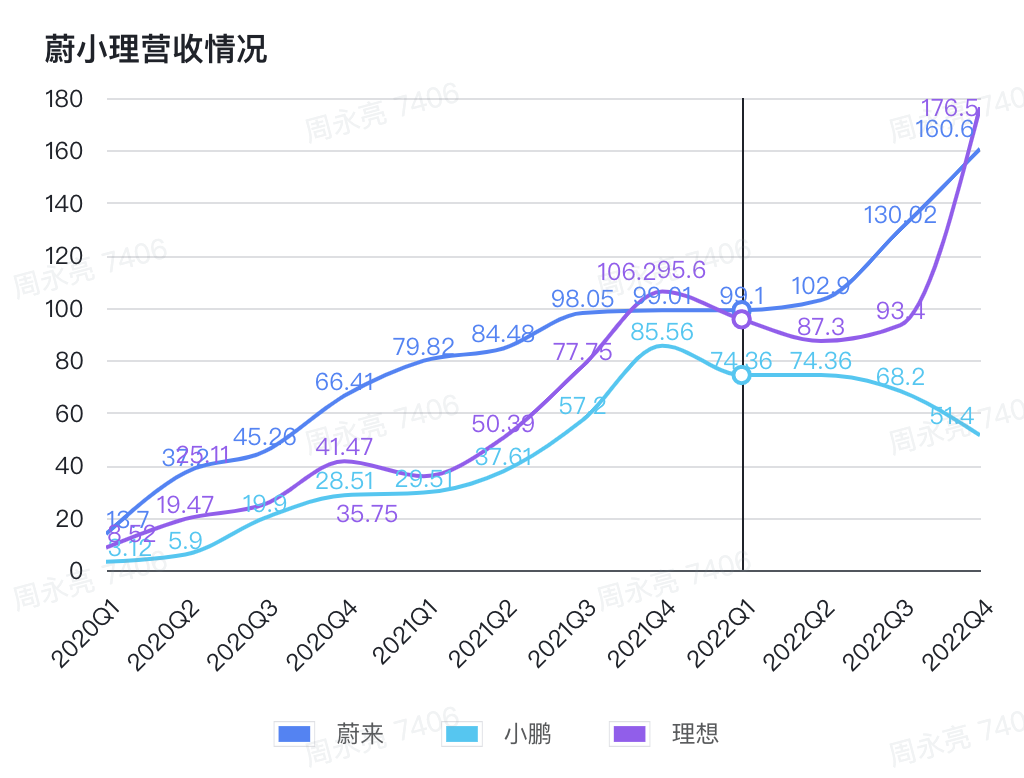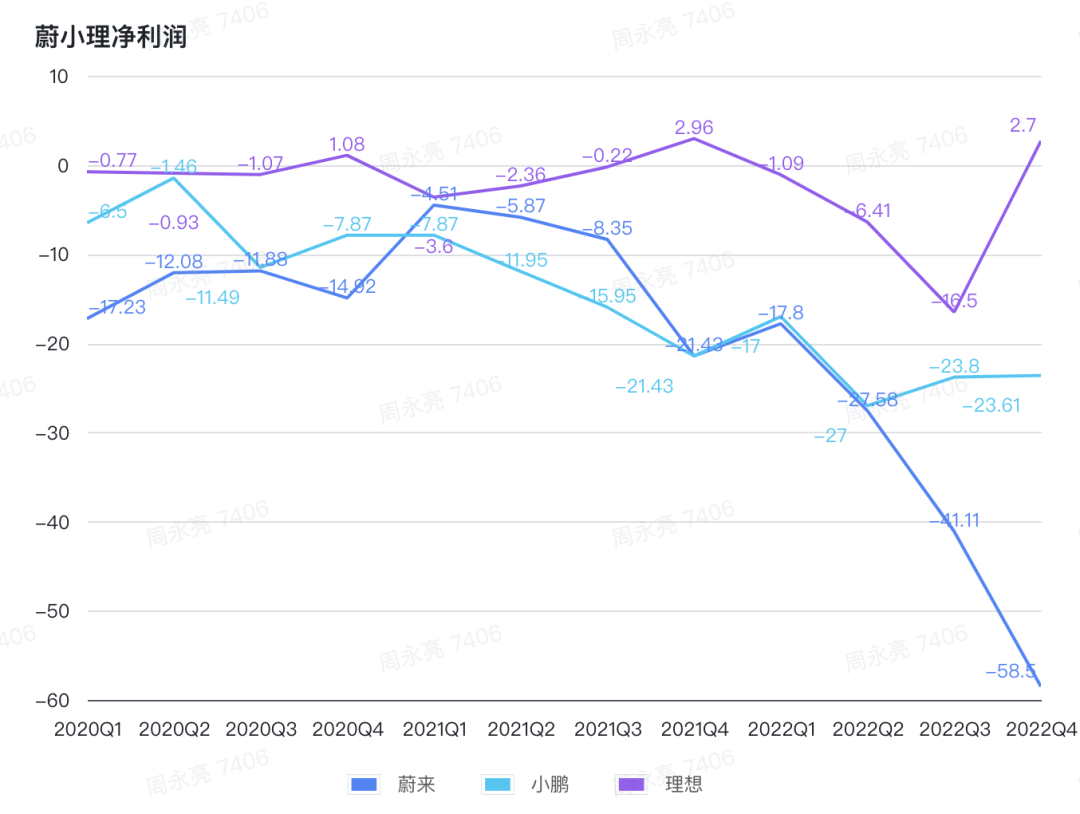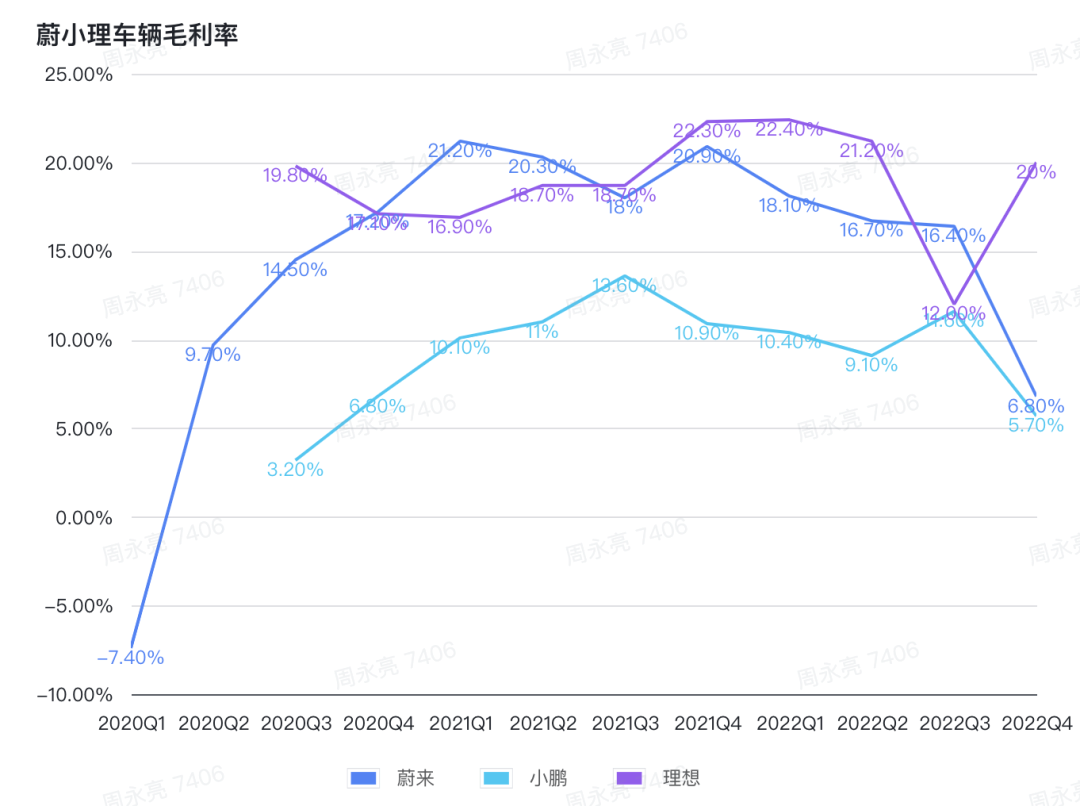Introduction
Recently, with the release of XPeng Motors’ financial report, all three star companies representing China’s new energy automobile industry have only performed passably.
In 2022, XPeng and NIO both completed product upgrades. NIO switched from the 866 platform (ES8, ES6, EC6) to the NT2.0 platform with 775 models (ET7, ES7, ET5); while Li Auto, after delivering the full-size SUV Li ONE at the end of August, released Li ONE Pro in late September. In September, Xpeng Motors also launched its strategic model G9.
However, the performance of NIO and XPeng has been vastly different. Li Auto which believed in the “hit product rule,” once again validated its methodology, while NIO achieved its bottom-line rebound after several seasons of poor performance. Xpeng Motors, which was the “best-selling” company in 2021, suffered major challenges and experienced a sharp decline in both sales and revenue after launching new models.
At the same time, the rhythm of the three new forces and the explosive growth of the industry have resulted in a mismatch. NIO’s growth rate between 2021 and 2022 ranged from 23% to 47%, much lower than the industry’s average growth rate (93.4%). On the one hand, this is because the automobile industry is a long-term cycle industry, and many accumulations require time. On the other hand, the three new forces originally planned to release second-generation products in the third quarter, but the product launches got delayed to the fourth quarter due to various reasons, which impacted the growth of sales for the full year.
As BYD and Tesla precede, new challengers like NIO and Huawei are also watching closely. In 2022, NIO will no longer just tell its own story as the “Chinese Tesla.” Being practical, surviving and staying at the table, these will be the most important tasks for NIO together with Li Auto and Xpeng Motors this year.
NIO: Ambitious, but average
If we review NIO’s 2022 performance, it can only be described as “average.”
Li Bin stated in an internal memo in January 2023, “In 2022, we have had our share of hardships, contributions, but we must soberly recognize that many of our peers have performed better than us during the same period.”
From a data perspective, NIO delivered a total of 122,500 vehicles throughout the year, an increase of 34% year-on-year. At the same time, NIO smoothly completed product upgrades, and based on the NT2, delivered three new models, ET7, ES7, and ET5. This data is lower than Li Auto’s 133,200 vehicles and higher than Xpeng’s 120,800 vehicles.
From the numbers alone, the gap between the three companies is not that huge, but it reflects in their revenue which has a significant difference. In terms of revenue, in 2022, NIO had the highest revenue in the three companies with ¥49.3 billion, followed by Li Auto with ¥45.3 billion and Xpeng with ¥26.9 billion.
There is not much difference in terms of car sales, but there is a significant gap in revenue, which is due to the difference in vehicle prices. In the past year, NIO and Li Auto’s average selling prices were ¥3.73 million and ¥3.31 million, respectively, while Xpeng’s was ¥2.07 million.
In the past year, all three companies went through the “pain period” of large-scale model updates. NIO was the earliest among the new forces of EV, and if we stretch the timeline, it maintained a delivery volume of 25,000 vehicles for four consecutive seasons from Q3 2021 to Q2 2022, although not declining, the growth rate slowed down significantly.
However, NIO was also the earliest new force in EV to break through the bottleneck. From Q3 2022, NIO’s new products began to be introduced, and entered a new growth cycle. In the last two quarters, NIO’s sales volume was 31,600 and 40,000 units respectively, with a year-on-year growth of 29.3% and 60%.
Although sales volume and revenue are turning around, the gross profit margin is falling sharply. Data shows that NIO’s auto gross profit margin last year was 13.7%, while in 2021, it was 20.1%, down 6.4 percentage points year-on-year. In comparison, Li Auto only decreased slightly from 20.6% to 19.1%, while Xpeng’s gross profit margin decreased from 11.5% to 9.4%.
Among them, NIO’s auto gross profit margin saw a significant decline in the fourth quarter, dropping to only 6.8%. In contrast, NIO’s auto gross profit margins were 20.9% and 16.4% in Q4 2021 and Q3 2022, respectively. Regarding this, NIO explained that due to the related inventory provision for ES8, ES6, and EC6 vehicle models, accelerated depreciation of production facilities, and losses of purchase commitments, these all affected the auto gross profit margin by 6.7 percentage points in Q4.
However, Li Bin expressed confidence during the earnings call that the vehicle gross profit margin will return to 18%-20% in Q4 2023. This judgment is mainly based on three factors: firstly, the product mix, NIO will be delivering models with higher gross profit margin starting from Q2 this year; secondly, the recent drop in raw material costs will also help increase this year’s vehicle gross profit margin; finally, starting from Q3 2023, the delivery volume will increase significantly, and the amortization rate of fixed costs will also increase.
As the gross profit margin declines, NIO’s losses in 2022 have also increased. Data shows that in 2022, NIO’s operating losses were RMB 15.64 billion, a year-on-year increase of 248%; net losses were RMB 14.44 billion, a year-on-year increase of 259%; and the adjusted net loss was RMB 12.14 billion, an increase of 304% compared to the previous year. This is the largest annual loss since the establishment of NIO.
At the same time, NIO’s cash reserves are rapidly depleting. As of the end of 2022, NIO’s balance of cash and cash equivalents, restricted cash, short-term investments, and long-term deposits was RMB 45.5 billion, a decrease of about RMB 10 billion from the end of 2021. Although this is 7 billion yuan more than that of XPeng, such rapid cash flow consumption is indeed worth noting.
Behind this, NIO’s huge layout has formed a unique long industrial chain layout in the vertical integration thinking. Accelerating the development of the self-developed autonomous driving system and chips, building a battery production line, acquiring equity in Australian lithium mines; In addition to the main brand NIO, planning to develop sub-brands Alpine and Firefly with a lower price, entering the European market in a high profile, and also wanting users to use NIO-brand smartphones.
Overall, NIO wants to do too much and invests too much in various fronts. In the long run, it may not be a bad thing, but it will inevitably face greater pressure in the short term.
XPeng “Squats” and Waits for Takeoff
Compared with NIO’s stability, XPeng’s performance last year was “up and down”. XPeng was once the best-selling newcomer in 2021, but in 2022, its sales were overtaken by NIO, Ideanomics, and Li Auto.

If we look at it separately, the fourth quarter was the worst. Data shows that in the last three months of last year, XPeng sold only 22,200 vehicles, much lower than Ideanomics (46,000 vehicles) and NIO (40,000 vehicles).This is mainly due to the lower-than-expected sales of XPeng’s main products. In the fourth quarter of 2022, XPeng’s main model, the P7, sold only 6,880 vehicles, a decrease of two-thirds from the same period last year (21,300 vehicles). The flagship SUV G9, which was highly anticipated by XPeng, delivered only 6,189 vehicles; the P5 sold 5,945 vehicles in the fourth quarter, which is significantly lower than the previous monthly sales of 6,000; and the G3 sold 3,190 vehicles.
After entering 2023, the gap between Wei Xiaoli and XPeng is gradually widening. According to estimated financial data, XPeng’s delivery volume in the first quarter of 2023 is expected to be between 18,000-19,000 vehicles, a year-on-year decrease of 45%-47.9%. In comparison, Li Auto is expected to sell 52,000-55,000 vehicles and NIO is expected to sell 31,000-33,000 vehicles, a year-on-year increase of 20.3% to 28.1%.
One of the underlying logics of the automotive industry is economies of scale. Slowdown in sales growth and low vehicle prices have affected XPeng’s gross profit margin. In 2022, XPeng’s gross profit margin fell from 12.5% in 2021 to 11.5%, while Li Auto and NIO were 10.4% and 19.4%, respectively, during the same period. In terms of automotive gross profit margin, XPeng’s was 9.4% in 2022, a decrease of 2.1 percentage points from 11.5% in 2021.
This also brought XPeng its largest loss since going public. According to financial reports, XPeng’s revenue in 2022 was CNY 26.86 billion, a year-on-year increase of 28%. However, XPeng’s net loss in 2022 expanded by 87.92% year-on-year to CNY 9.14 billion. Among them, operating losses were CNY 8.706 billion, an increase of 32.31% over the previous year.
All issues, on the surface, appear to be product, sales, coordination, recruitment or coordination problems, but in the final analysis, they are all organizational problems.
However, changes are happening. At the end of 2022, XPeng began a strategic review and adjustment, promoting the optimization of the organizational structure, and addressing the shortcoming of comprehensive capability. In January 2023, XPeng announced that Wang Fengying had officially joined XPeng as the CEO.
Recently, He XPeng stated during the 2022 financial report conference call that currently, all of XPeng’s R&D, production and supply chain systems report directly to him. CEO Wang Fengying is fully responsible for product planning and sales service system, significantly enhancing sales service capabilities and efficiency and further strengthening brand marketing. In the next two years, XPeng will further strengthen network layout and enhance the fighting capacity of frontline sales personnel through the flattened management of the sales network.Meanwhile, He XPeng pointed out that Wang Fengying’s biggest criticism of XPeng Motors was that it had not done well in planning and marketing. Wang Fengying is now juggling both tasks, instead of tackling them one by one. Wang Fengying works seven days a week and they are now working seven days a week since the launch of the redesigned P7i, which shows that XPeng has made significant progress in terms of organization, product, and marketing.
Next, XPeng’s biggest hope may be the new G6, which is XPeng’s own “Model Y.” “We believe that the G6 will become a hit that ranks among the top in the market, and after mass production, it will achieve two to three times the monthly sales target of the P7.” According to reports, the G6 will debut at the Shanghai Auto Show and be officially launched and delivered in the second quarter of this year.
He XPeng said, “Starting from the third quarter of this year, XPeng Motors’ sales volume will see a significant year-on-year and month-to-month increase, and a large proportion will be higher than the industry growth rate.”
At present, the capital market still recognizes XPeng’s recent adjustments. The stock price has also risen 16% from $8.33 before the financial report was released to $9.7.
Ideal: Excitement from outside, dissatisfaction from inside
For the past three years, Ideal has been considered the “third brother” of the new forces. However, today, Ideal has not only gone from 0 to 1, but also overtaken NIO and XPeng, becoming the “big brother” in terms of both stock price and sales volume.
In terms of delivery volume, Ideal Motors delivered 133,200 vehicles in 2022, a year-on-year increase of 47.2% from the same period in 2021, second only to Li Auto (152,000 vehicles) among new forces, and higher than NIO (122,500 vehicles) and XPeng (120,800 vehicles); in terms of market value, as of the time of writing, Ideal Motors’ latest total market value is $24.254 billion, which is the sum of NIO ($15.185 billion) and XPeng ($8.369 billion).
However, Li Xiang only completed one of the two goals he set at the end of last year. In November 2022, after Ideal Motors released its delivery data for October, Li Xiang stated on Weibo that “Ideal strives to achieve monthly revenue of over 10 billion yuan in 2022. The moment when L9 and L8 are delivered at the same time is also the time to say goodbye to 7 years of continuous loss-making.”
At present, Ideal Motors has indeed achieved annual profitability, but has not yet achieved monthly revenue of over 10 billion yuan. In 2022, Ideal achieved profitability again, which is rare in domestic new energy vehicles. The financial report shows that Ideal Motors’ full-year revenue in 2022 was RMB 45.29 billion, a year-on-year increase of 67.7%. Among them, Q4 revenue was RMB 17.65 billion, a year-on-year increase of 66.2%; full-year net loss was RMB 2.03 billion, and Non-GAAP net profit was RMB 21 million. Among them, Q4 net profit was RMB 265 million, and Non-GAAP net profit was RMB 968 million.
What really matters behind this is the gross profit margin which is in the industry’s first tier. As data shows, Ideal Car’s gross profit margin of the whole year is 19.1%, which is slightly down by 1.5 percentage points from the full-year gross profit margin of 20.6% in 2021, but still at the top level of the industry. Among which, the vehicle gross profit margin of Ideal Car in the fourth quarter is 20.2%, a rise of 8 percentage points compared with the third quarter (12%), only down 2 percentage points from the peak of 22.4%.
Although Ideal Car achieved good results last year, the high-level management seems dissatisfied. It was learned that Ideal Car’s employees received discounts on the year-end bonus, and some employees only received half of their monthly salary while a minority received thirteen salaries. In previous years, Ideal Car’s year-end bonus was around 14 to 16 salaries.
The main reason behind this is: the company did not achieve the sales targets set at the beginning of the year. According to the annual plan at the beginning of 2022, Ideal Car’s target was to deliver 170,000 vehicles, but the year-end data showed that Ideal Car had delivered 133,200 vehicles with a completion rate of 78.38%.
Of course, NIO and XPeng did not succeed either. NIO’s sales target was 150,000 vehicles, and XPeng’s was “25 million guaranteed hits, striving for 30 million hits”. But in the end, NIO, with the lowest set target, achieved eight-tenths of its goal, while XPeng, the top seller in 2021, did not even achieve half of its “guaranteed” target.
It is worth mentioning that Ideal Car has achieved positive free cash flow for three consecutive years, becoming the company with the most cash reserves among the three. As of the end of 2022, Ideal Car’s cash reserves reached 58.45 billion yuan, the operating cash flow for the year was 7.38 billion yuan, the capital expenditure was 5.13 billion yuan, and the free cash flow for the year was 2.26 billion yuan.
This means that from the perspective of cash and cash flow, Ideal Car has fully achieved its self-generation ability, which can maintain its healthy development even in a poor external environment, relying on its own self-generation ability.
Today, the competition among intelligent electric vehicles has entered the later stage of the qualification race. If in the first two years, new energy vehicles could still rely on precise positioning, distinctive design, high-end smart systems and other differentials to gain market share, today, Ideal Car has gone from 0 to 1. The competition has shifted to scenarios and user experience, as well as the systematic capabilities behind them.
This article is a translation by ChatGPT of a Chinese report from 42HOW. If you have any questions about it, please email bd@42how.com.
